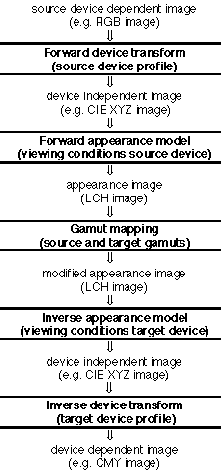

ERCIM News No.26 - July 1996 - CNR
New Methods for Colour Analysis and Reproduction
by Anna Della Ventura and Raimondo Schettini
Some new approaches to colour matching have been developed at the
Institute for Multimedia Information Technologies (ITIM) of the Italian
National Research Council (CNR). The application areas are all those requiring
colours to be specified, displayed and communicated both in terms of colorimetric
coordinates or recipes and in terms of device-dependent coordinates (eg
Red, Green and Blue for the monitor) maintaining the perceptual matching.
Typical areas in which colour is an important feature of the product and
where these methods are being proposed are: textile printing and dyeing,
ceramic, paper, paint and plastic products, quality control for food production,
visualisation of products for sales, and fast communication between CAD
and production equipment.
When the information handled, stored or communicated by computer systems
concerns colour, genuine difficulties are encountered in quantifying and
reproducing this attribute. The fundamental reason is that the colour generated
on different computer peripherals, captured by digitizing devices (eg scanners,
or cameras) or measured on the surface of objects by instruments such as
colorimeters or spectrophotometers is not only a physical property of the
material or of the device, but must also be considered with respect to the
visual sensation that it produces in the beholder.
Our knowledge of the mechanisms of vision and the models derived from them
does not yet enable us to completely master the phenomenon of the perception
of colours, bearing in mind all the subjective and environmental factors
involved. As things stand, however, it is possible to arrive at approximate
solutions that, under partially controlled conditions of observation, and,
above all, using calibrated devices - whose performance, in other words,
is predictable - will produce a satisfactory perceptive colour match. Here
below we list some of the problems that we are now addressing and describe
the methods being adopted.
Colour sample rendering on cathodic ray tube
The device is colorimetrically characterised (the mapping remains valid
even when the display is changed, and provides a suitable basis for reproducing
the colours on other media), and a colour vision model is adopted to take
into account all aspects of viewing conditions, such as white-point, luminance
level and surrounding conditions.
The mapping between the RGB and the CIE (International Commission for Illumination)
XYZ tristimulus values (device calibration) is based on certain assumptions
about monitor performance that must be verified: if these prove untrue,
calibration accuracy is limited. The colour vision model adopted can be
considered an extended/modified version of the standard CIE-LAB color model.
The main advantage of the method adopted is that many of its parameters
may be quantified by low cost equipment (or even heuristically). A method
has also been developed in which unreproducible colours are approximated
by projecting them onto the surface of the monitor gamut.
Colour scanner calibration
As special instrumentation and tedious measurements are often required to
calibrate input devices, it is common practice to waive the whole process
and accept unmatched colours throughout the system, sacrificing objectiveness
to practicality. A simple method for colour scanner calibration has been
developed. This method has several advantages over other approaches: it
requires no estimation of the technical characteristics of the device, and
employs a simple neural network trained by back propagation. Moreover, the
network makes use of a standard, easily available, colour chart as the training
set (IT8).
Colour printer calibration
A calibration method must require the smallest possible number of measurements
of the colours in the device gamut, must be computationally effective, and
as far as possible must be independent of the technical characteristics
of the device being calibrated. Our experimentation is based on trilinear
interpolation algorithms, cross-correlated smoothing splines, and feed-forward
neural networks. All the methods employed are very general, and can be applied
to calibrate virtually any colour device.
Gamut Mapping
The method developed does not limit the gamut of colours available on the
display to those which can be reproduced precisely on the printer. It consists
mainly in compressing and deforming, in accordance with a interactively
defined strategy, the three-dimensional solid that envelops the colours
of the image displayed on the monitor in the solid that represents the printer
gamut.
Given an image on the monitor, the monitor calibration algorithm is used
to calculate the CIE coordinates of its pixels. In accordance with the compression
strategy employed, the mapping of the gamut transforms the group of CIE
values in the input, all of which lie within the monitor gamut, into another
group of CIE values, all of which come within the printer range (see Figure).

Figure: Processing steps in cross-media colour matching
A preview mechanism, and tools for editing colour clusters have been
developed to reduce (or eliminate) the probability of not obtaining satisfactory
results.
Recovering of reflectance functions from tristimulus values
Given a CIE XYZ triple, the method employed makes it possible to find a
spectral reflectance function characterising an object colour. When an object
is illuminated by a given illuminant, it produces a metameric spectral power
distribution, ie one with the same XYZ tristimulus values.
The method proposed can be used easily and effectively to fill the gap between
CAD and colour production systems. In the framework of a CAD/CAM application
the method would allow changes in appearance of the object colours under
changing illuminants to be simulated, and could be generalised so that the
derived function minimises the metamerism indices for different illuminants.
Please contact:
A. Della Ventura - ITIM-CNR
Tel: +39 2 706454
E-mail: adv@itim.mi.cnr.it
or
R. Schettini - ITIM-CNR
Tel: 39 2 706488
E-mail: centaura@itim.mi.cnr.it
return to the contents page


